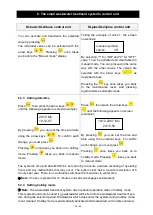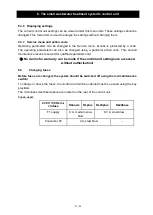
8. Operation and maintenance
39 / 54
Weekly checks
(Weekly checks are not prescribed, but are recommended)
Check water levels, sludge must not enter the SBR chamber uncontrolled.
Check the supply and discharge routes for blockages (visual check).
Read operating hours counter for air compressor (total operating hours), aeration (valve
2) and sludge return (valve 4) and if necessary any other units and note in operating log.
Check function of lifters and aeration using the "Manual mode" setting.
Monthly checks
Visually check for any sludge leaks, clouding or discolouration in the discharge.
Check the supply and discharge routes for blockages (visual check).
Read operating hours counter for air compressor (total operating hours), aeration (valve
2) and sludge return (valve 4) and if necessary any other units and note in operating log.
Checking the air filters:
The filter for aerating the control cabinet (ventilation grille on left and right in housing wall
of internal cabinet or on rear of external cabinet) should be checked and cleaned or re-
placed if required. The grille on the outside of the cabinet must be removed for this pur-
pose. Apply a little pressure with a screwdriver to release the clip fastener and remove
the grille by hand. The filter mat is not secured in the ventilation shaft and can be shaken
and/or blown out.
The time at which the air compressor filter is to be cleaned or replaced depends on the
extent of contamination caused by the atmospheric conditions of the application. Follow
the service documents provided by the compressor manufacturer to check or replace the
filter on the compressor.
Emptying sludge
8.2
The level of sludge that has accumulated in the sludge reservoir is measured by a maintenance
specialist using a sludge plunging siphon. Systems with DIBt approvals are designed such that
the sludge reservoir compartment is generally sufficient for 12 months if run permanently at full
load and if the operator and maintenance obligations are met. This period extends accordingly if
used less. DIN stipulates "empty sludge as required", i.e. if a high level of sludge is measured
during maintenance, it must be reduced. Floating sludge must also be taken into consideration
during the measurement. The sludge should be disposed of when the sludge reservoir is 70%
full or before. The operator must arrange for the sludge to be disposed of.
If maintenance and sludge removal are to be undertaken at the same time, perform mainte-
nance first. Sludge removal should be noted in the operating log. Note the information provided
by your specialist firm.
















































